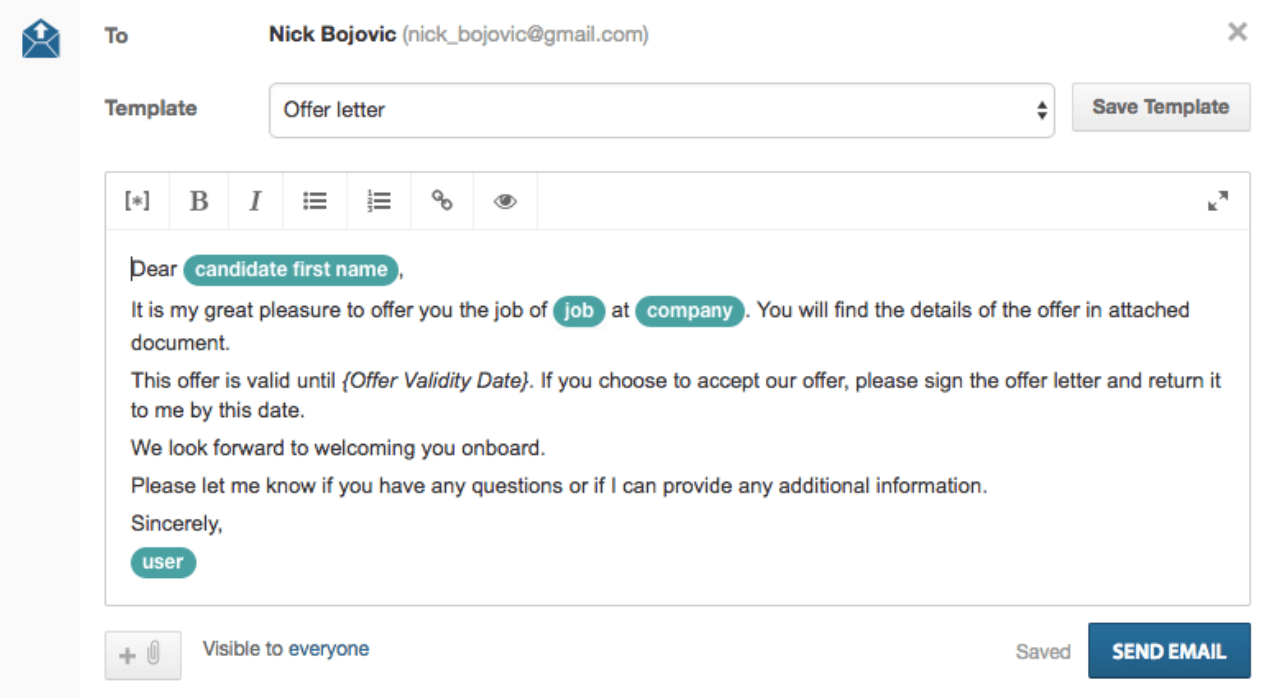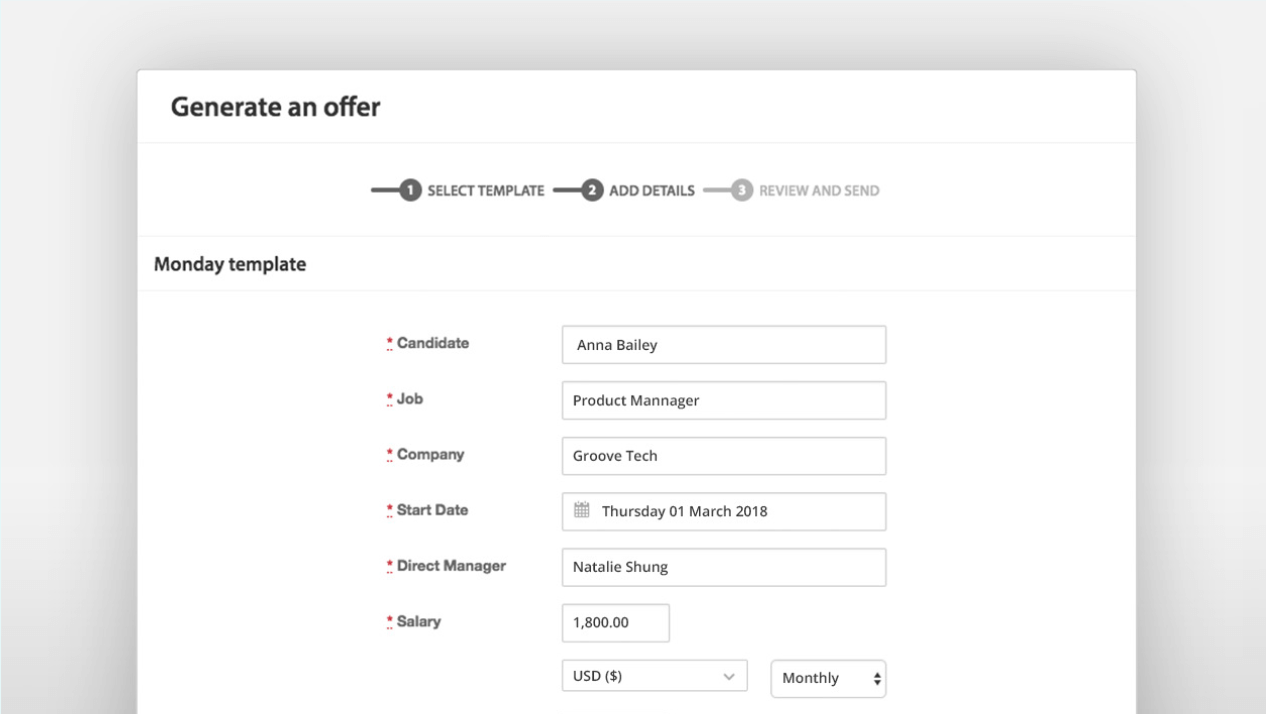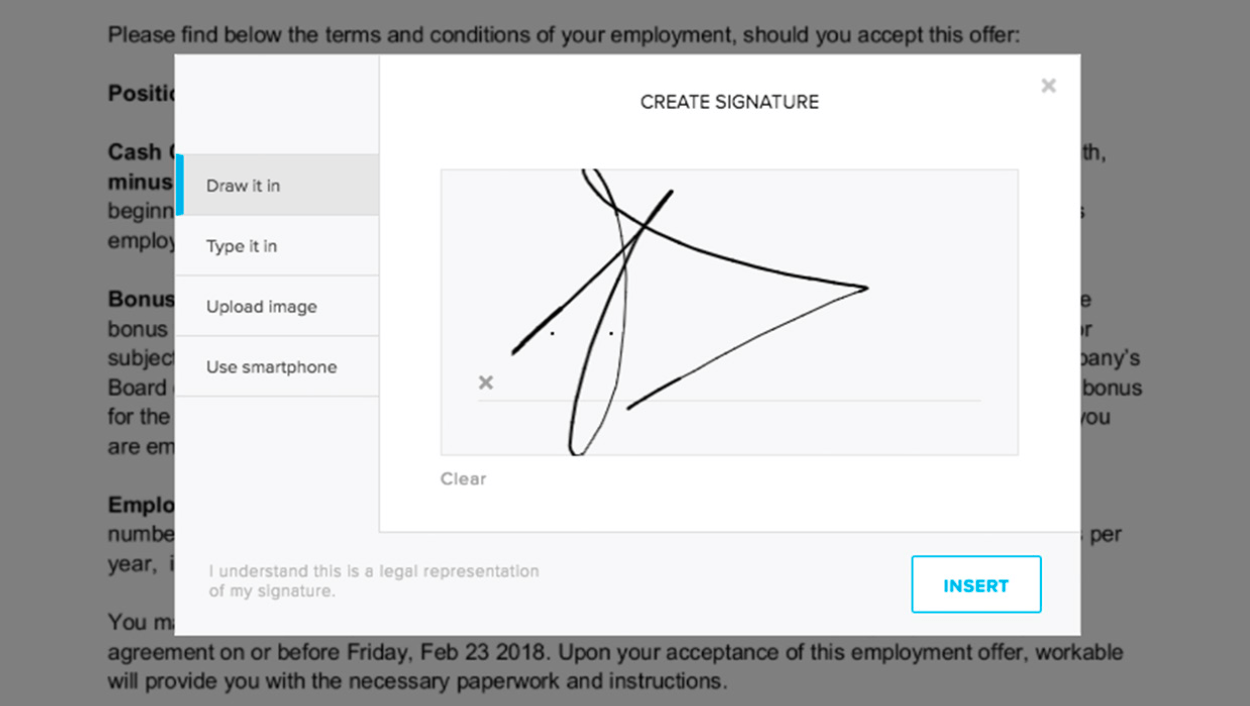Designing a successful job offer strategy: a definitive guide
It’s a common recruiting mistake to think that your best candidates will definitely accept your job offer. After all, they’re likely someone else’s best candidate, too. To stay competitive and hire the best people fast, your job offer strategy needs to be as efficient as your recruiting process. This Workable guide includes resources to help you overcome job offer challenges, with tips on how to write and negotiate better offers and design a better job offer process.

- Get more out of your job offer strategy
- Writing the offer letter
- How to speed up the offer timeline
- Navigating offer negotiations with candidates
- Measure your offer letter strategy success
- How Workable helps you optimize your job offer process
1. Get more out of your job offer strategy
Making a job offer is one of the most emotional parts of the hiring process. You put yourself out there by asking someone to join your organization. You’ve disqualified dozens of candidates. You’ve found the one. You want this person to say yes, because you’ve spent a lot of time, and presumably money, to move them through your recruiting process. Naturally, the offer stage should be light at the end of the tunnel.
Except when it’s not.
Almost half of employers in a recent recruiter sentiment study said their offer rejection rates range from one to 10%. Top reasons candidates turned down offers included: accepting another job, insufficient compensation and lengthy hiring practices.
How do you counter these challenges? In this guide, we’ve compiled resources that provide an overview on how to write, optimize and measure your offer letters and job offer strategy. We’ll also walk you through how Workable can help you track and manage your offers, all in one place.
2. Writing the offer letter
You don’t need to be Hemingway to write a compelling offer letter. All you need is:
- A welcoming email to introduce your offer; and,
- A formal offer letter document to attach to your welcoming email
Your welcome email can be casual and short, but make sure to include all essential job information in the formal offer document. Include:
- Position details (job title, who your hire will report to and their working schedule)
- Compensation
- Bonus or commission, if relevant
- Employee benefits and perks
- Privacy policies
- Termination conditions, if relevant
- E-signatures from managers
- Date the job offer expires
Tip: Templates make the writing go faster. Once you’ve decided on a style you like, save it to use for later.
Communicating the job offer
Make sure to both call and email candidates to announce you’re extending a job offer before you send the formal letter. When you send your offer letter via email:
- Use an email subject line that clearly states this is a job offer, for example, “Job offer from [Company_name]” or “Job offer for the position of [Job_title] at [Company_name]”.
- Keep the email body text brief and note that the candidate can find the detailed job offer letter attached.
- Set a specific timeframe for when you would like to get your candidate’s final response.
- Personalize the email body text and tweak the tone to match your company culture. But, try to keep the language in your employment offer letter formal and clear, as it’s an official document that describes employment terms between you and your future hire.
For more offer letter templates, visit our Resources library. Here are some samples to check out: part-time to full-time offer letter, contract employee offer letter, informal offer letter sample and job offer email.
3. How to speed up the offer timeline

Time is your competitive advantage in today’s candidate-driven market. Your best candidate is likely to be another company’s best candidate too, and odds are they’re juggling multiple offers. To hire talented and qualified people, create an offer process that moves as fast as they do.
Here are a few tips to consider when thinking about how to speed up your offer process:
Establish your offer approval process before you open a job
Ask the following questions so that when you are ready to offer a job to your best candidate, you’ve got all the information you need to move swiftly.
- Who should approve your job offer?
- Who should sign off on your job offer document?
- Who does this role report to?
- What is the pay range for this position?
- What will the final compensation package depend on?
- Are there any bonuses associated with this position?
- What kind of benefits will you offer?
- How many days should you wait for a candidate to accept your offer?
Take a look at overall time to hire
Where else might your recruiting process lag? A patchwork offer approval process can add weeks to your hiring. But if you’re struggling with lengthy hiring already (for example, too many candidates, multiple interviews, navigating a sea of spreadsheets), stand back and eye your entire hiring process. Is it as efficient as it can be? Are you:
- Including knockout questions in your application form?
- Actively sourcing passive candidates?
- Posting targeted ads to the right job boards?
- Moving qualified candidates through your pipeline by using a solid set of screening questions?
Your ATS can enable you to do all these things, saving you a lot of time toggling between multiple tools and platforms. Learn how Workable can help you create custom applications, post jobs for free, screen candidates and source passive talent.
Automate your offer process with software
Recruiting software can help you speed up your overall hiring process through features that automate time-consuming tasks. Applicant tracking systems store email templates, enable you to exchange comments about candidates with the hiring team and help you extend and approve job offers.
Here are ways an ATS helps you streamline your hiring and offer process:
- Track all back-and-forth emails with team members during the offer approval process.
- Create offer letters that are error-free, engaging and on-brand. Craft offer letter document templates to ensure all the details are included and correct.
- Track candidates’ answers and negotiation requests. Enable candidates to accept an offer fast (through desktop or mobile) via e-signatures.
- Gain a clear overview of who has taken action and who hasn’t, so you are able to follow up with team members or candidates.
- Keep all candidate information in one place for easy reference.
Workable’s Offer Letters and Offer Approvals feature streamlines and automates key stages in the process, making it quicker to write, approve and send your offer. It also includes e-signatures, making it easier for candidates to accept, and your hiring team to keep track of the details.
4. Navigating offer negotiations with candidates
You’re almost there. Your best candidate is interested in your job offer, but they might want to negotiate key terms — most likely compensation. How much wiggle room do you have as a recruiter, hiring manager or employer? And how do you negotiate between all parties tactfully?
Here are three tips to set offer negotiations up for success:
a. Establish salary ranges before you advertise the role
For each position you’re hiring for, be sure to have a budgeted lower and upper band to orient your approach to the salary negotiation. Your lowest offer should still be in line with industry standards and be attractive to your candidate. When you talk to candidates early in your process, make sure you tell them what the budgeted salary range is for the position. This allows them to self-select out if your range doesn’t meet their expectations, saving you time later on.
b. Ask candidates what they want early in the hiring process
Put people first and numbers second. Asking candidates about their desired compensation plan positions you and your employer brand as helpful and consultative. And, by understanding what’s important to your candidate you’ll better understand how to appeal to their needs during negotiations. This approach also sets you up to create a talent pipeline with qualified candidates who might not be a good fit now but who might be interested in a future role.
c. If you can’t offer more money, consider non-cash benefits

Get creative with perks and benefits. Flexible work time is one of the most important perks to most job candidates. If you offer some other non-salary benefits and perks, like stock option plans, free snacks and beverages, fitness memberships — consider including those, too.
When candidates decline your job offer
Offers still get declined, even though you’ve done everything you can to get candidates to say yes. Every hiring process is an opportunity to learn. No matter what happens, you walk away with more knowledge about the market you’re recruiting in. And rejection is a good opportunity to learn how to optimize your methods.
Here are some ways to deal with offer rejections from job candidates:
Document what happened. Whether it’s through a candidate experience survey or a phone conversation, find out why your best candidate said no. After a while, you might begin noticing patterns. Are you always losing candidates because you don’t offer a a 401(k) retirement plan? Is salary consistently a sticking point? Or does your process need to be faster, because candidates accepted another offer while you were waiting to get back to them? These are all valuable insights that you can do something about, but only if you document them.
Revisit your recruiting pipeline. Always have a Plan B. Create a structured recruiting process that is constantly moving talented candidates forward. If Candidate A rejects your offer, Candidate B should be just as qualified and ready for a final interview with your hiring manager. Good interview scheduling software that integrates with your calendar and ATS can do this for you swiftly and seamlessly.
Be flexible enough to modify your offer. Offers fall apart when both sides are inflexible. So what can you do to meet somewhere in the middle? Savvy candidates who know their market worth will often counter-offer if your original offer doesn’t meet industry standards. If you’ve established salary ranges early in the hiring process, try to negotiate within the range to a place all parties are comfortable with. Or, take another look at your ranges to make sure they’re market-rate.
When candidates accept your offer
If your candidate accepts your offer, congratulations! The next step is to set your new hire up for success. Make sure to:
Write a welcoming offer letter. Follow up a verbal offer with a written one. This can be formal or casual, depending on your company culture, but make sure to be clear about the position details. Convey that you’re excited about your new hire joining your team.
Encourage the hiring team to get in touch. Make sure the hiring manager and all stakeholders in the hiring process have the new hire’s personal email. Urge them to contact the new hire and congratulate and welcome them to the team. This sets the stage for a friendly and warm first few days at work.
Create an onboarding plan. If your hiring process gets rave reviews from candidates – great. Follow it up with a structured onboarding process. Send new hires a detailed onboarding plan, which should cover what their first week at work will look like. Include meetings with managers and team members, a welcome lunch, orientation and any other events.
5. Measure your job offer strategy success
Much like other parts of recruiting, your job offer strategy needs to be tracked. How else will you know if it is effective? There are a few KPIs you can measure to take the pulse of your job offers:
a. Offer Acceptance Rate (OAR): This metric tells you what percentage of candidates accept your job offers. It indicates how attractive and competitive your job offers are. If your OAR starts declining, then your team isn’t hiring the candidates they want. A low OAR could lead you to rethink your jobs’ salary ranges or try new ways of communicating with candidates.
Here’s the formula to measure your offer acceptance rate (OAR):

b. Reasons Offers are Being Accepted: This metric tracks the primary reasons candidates give for accepting your job offers. To measure the Reasons Offers are Being Accepted metric, ask your new hires why they accepted your job through your candidate experience survey. It’s best to use an open-ended question to gain more personalized insight (for example, “Why would you choose/not choose to apply for a future opening at our company?”) When you have enough data, group answers under a few useful categories (for example, competitive salary, challenging job).
c. Reasons Offers are Being Rejected: This metric tracks the primary reasons candidates give for rejecting your job offers. It provides insight into what you can do to ensure your best candidates accept your offers. You could measure the reasons offers are being rejected in various ways:
- Check your candidates’ communication with your hiring team. Some candidates may state a reason for rejecting your job offer in their rejection email or mention a concern during offer negotiations.
- Ask candidates to complete an anonymous candidate experience survey. Use open-ended questions to get the most descriptive responses (for example, “What are the two most important reasons for you rejecting our job offer?”)
- Track feedback online. Pay attention to your company pages on sites like Twitter, Glassdoor and Facebook. Candidates might be inclined to leave public feedback there on why they rejected your job offers, or on any other aspects of your hiring process. Compile comments to gain actionable insight, and consider any ways to improve your brand.
6. How Workable helps you optimize your job offer strategy
The offer is the most significant part of your hiring process, yet it is one of the easiest to get wrong. That’s because most job offers require a lot of data entry and virtual (or manual) flagging down managers for approvals. This leads to longer time to close hires, and a prolonged time to fill.
Workable helps you get offers out faster
Workable’s offer feature is designed to keep your Offer Acceptance Rate (OAR) healthy. It streamlines and automates key stages in the process, making it quicker to write, approve and send your offer. It also includes e-signatures, making it easier for candidates to accept, and your hiring team to keep track of the details. Here’s how:
A library of templates
It’s easy to build up a library of templates for every role. Upload your own template or use one provided. All you need to do is decide on the unique information you want to include in each offer. Choose from a list of variables, such as start date or salary, to customize every document automatically. These are displayed as placeholder text, and will be automatically replaced with the appropriate data per candidate. Once saved, your templates are available for key members of the hiring team to use for successful candidates in the future.

Real-time offer tracking and notifications
Live status tracking on a candidate’s profile makes it simple for the hiring team to follow the progress from offer to acceptance. By glancing at the timeline see the current status of an offer (pending approval, sent, accepted, declined) and receive automatic notifications when the status changes. With real-time updates you can react quickly if an offer is declined; review your original offer, submit it for approval and send a counter offer.
E-signatures
Integrated e-signatures make it simple for candidates to accept – all it takes is two clicks. As well as saving valuable time (reducing back-and-forth emails) it also makes for a stronger candidate experience. Onced signed, a copy of the document is available on the candidate’s timeline. You can also choose to include a company e-signature on your offer document.
Optimized for mobile
Candidates can read and sign your offer document from any device (desktop or mobile). So wherever candidates are when you send your letter (in the office or on the train) they can accept quickly and easily.
Automated approval workflow
When you’re juggling multiple offers for different hiring managers, getting fast approval is a challenge. Workable’s Offer Approval feature is designed to support larger companies with complex workflows, by automating the approval process.
It shortens the time it takes to get an offer to a candidate. Just create an approval workflow for each template and add the people you need to sign-off each offer. Approval requests will then be sent automatically to each approver. This means hiring teams are free to focus on other tasks while the approval process runs its course.
Restricted access rights
For large organizations, there’s the option to save templates so that only people associated with specific departments and locations have access rights to the content. This enables you to maintain appropriate levels of privacy and control over access to potentially sensitive information.
Get the content right
Offer letters set the tone for the ongoing relationship between your company and your future employee. As an official document, a good offer needs to tick a number of different boxes. From showcasing your company’s brand and culture to accurately reflecting all the relevant job details, getting the content right is key if you’re to move quickly and seal the deal.
Having a library of offer document templates ready to go means that anyone in
your hiring team can make an offer confident that all the right information has been included. And because the format is standardized, your hiring team’s approach will be consistent across all of your job offerings.
When you’re ready to make an offer just select the correct template for the job. Then add in the details unique to each offer (for example, the salary offered). Every offer letter comes with a pre-drafted covering email, which your hiring managers can edit to further personalize their approach.

How the offer and approval process works
Build a library of templates:
- Create templates for each job – upload your own or select a pre-prepared version.
- Choose the variables you want to include.
Make an offer:
- Select the relevant template.
- Add in the details unique to each offer (for example, the salary offered.)
- Wait for feedback or offer approval, if appropriate.
- Once approved, review your offer, editing the covering email if you want to.
- Send to the candidate.
Create a positive candidate experience
Directly linked to recruiting performance, the candidate experience you provide can mean the difference between an offer being accepted or declined. By managing the entire offer letter process inside Workable, candidates will receive seamless and timely communication from the moment they apply to the day they start their new job with you.
This is crucial when it comes to building a positive candidate experience. And enhancements designed to speed up the process (e-signatures, mobile optimization) show you’re serious about securing their talent and want to make it as easy as possible for them to accept. Another tick in the box.





